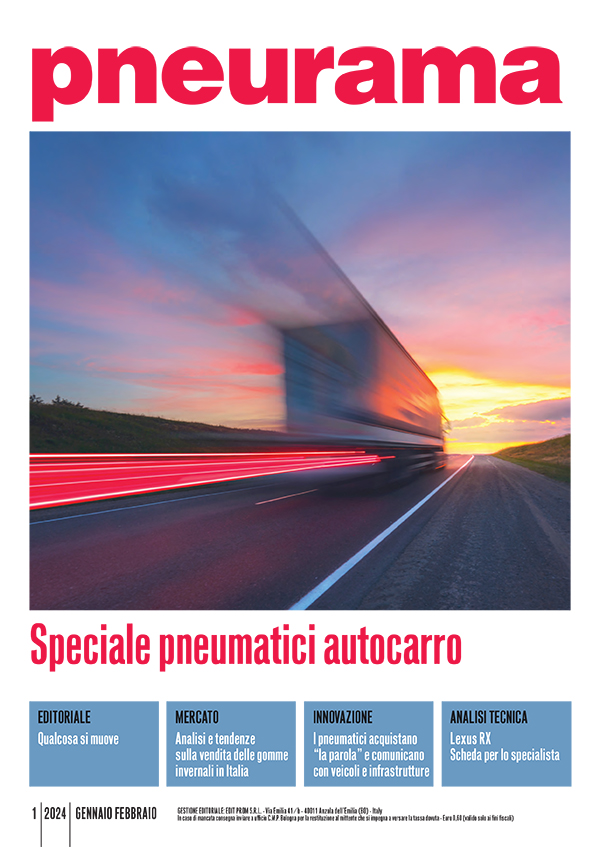Shortage of truck drivers: a worldwide problem
Europe alone is short of 400,000 drivers. Issues with safety and salaries behind the decline

Great news in the field of road haulage management both at national and European level. Starting from the absolute top in Italy, namely the Ministry itself - which, after changing its name into Ministry of Sustainable Infrastructures and Mobility - is now tackling its internal reorganization, adapting its structure to the new name and the tasks ahead. The recent decree issued by the President of the Council of Ministers makes clear the main principles behind the new organization: sustainable mobility as a driver of change for the lives of people and companies with a view to improving connections between territories. Equally vital is the recognition of the strategic role played by new technologies in managing future integrated transport systems for both people and goods to ensure efficiency and safety and, finally, a more sustainable organization and management of the Ministry.
"In short, a new working approach within the ministry, as the change of name and organization responds to a change of strategy, which provides for packages of integrated actions on infrastructure and mobility, dropping the sectoral logic, experimenting and applying new technologies in a vision of sustainable development fully in line with European guidelines and the orientation of this Government, explained Minister Giovannini directly. "All this is accompanied – says the minister – to a new vision, which includes not only changes in the organizational structure, but the cultural approach in favour of an integrated vision of all activities: all the departments have already fully implemented the new operational lines, as demonstrated by the projects included in the Piano Nazionale di Ripresa e Resilienza (National Recovery and Resilience Plan) already approved by the European Commission." The change in name and organization are clearly seen in the ministry's new logo, which graphically depicts the new vision, in line with the sustainable goals set within the UN Agenda 2030 and the principles of the Next Generation EU. Around the star of the Republic in the centre of the image, which defines the institutional component, other elements are depicted symbolizing the new course, including infrastructure and sustainable mobility, circular economy, interconnection, inclusion, as well as the colours representing the UN Agenda 2030 related to the ministry and the missions of the RRP. Great focus then on transport. And the fact that logistics represents the backbone of the country’s economic system is also the opinion of Umberto Ruggerone, neopresident of Assologistica – also adviser of the Logistics and maritime economy groups of Confindustria, and president of Confetra’s Commission of digital innovation – who highlighted the hot topics for the sector: from contract logistic to harbour terminals, from general warehousing to logistic hubs, "all vital for our national logistics: we are all aware of the extraordinary period we are going through, hence managing complex issues and revitalizing both our society and economy are challenges that demand effort and collaboration from all parties involved".
 "Logistics, a universe of activities, skills and knowledge - he insists - has proven its ability to face and manage unexpected events and emergencies. So, it is precisely from here that we need to restart. We need to make people understand that companies in this sector represent the backbone on which to create and run a new, more efficient, effective and sustainable domestic “Economic System”. Companies that invest in innovation create employment and contribute significantly towards making Italy more dynamic, competitive and liveable. Companies that come up with suggestions and proposals and, as such, must be supported and protected". Furthermore, according to TransportIntelligence analysts, the market must face challenges such as reduced employment, which will weaken the spending power of citizens. This may undermine economic growth, hindering the return to pre-pandemic levels.
"Logistics, a universe of activities, skills and knowledge - he insists - has proven its ability to face and manage unexpected events and emergencies. So, it is precisely from here that we need to restart. We need to make people understand that companies in this sector represent the backbone on which to create and run a new, more efficient, effective and sustainable domestic “Economic System”. Companies that invest in innovation create employment and contribute significantly towards making Italy more dynamic, competitive and liveable. Companies that come up with suggestions and proposals and, as such, must be supported and protected". Furthermore, according to TransportIntelligence analysts, the market must face challenges such as reduced employment, which will weaken the spending power of citizens. This may undermine economic growth, hindering the return to pre-pandemic levels.
According to TransportIntelligence, Europe's current vaccination rate could also inhibit growth, as continued restrictions on people's movement will limit economic recovery. Brexit represents a further European challenge: delays and confusion caused by new cross-border procedures are reducing volumes of traffic and prompting shippers to avoid transport with Britain. At the end of the research, TransportIntelligence analysts admit that the transport market will not reach pre-pandemic levels by the end of 2025. Turning to Europe, the reform of the Eurovignette - the road toll authorized by the European Union to compensate for external costs caused by pollution and congestion and to finance road infrastructure - took an important step forward on June 16. In fact, a political agreement, albeit still informal, was reached between the European Council, representing the Governments, and the delegation of the European Parliament.
The text imposes stricter standards and a new system for CO2 emissions. The main innovation for the transport industry concerns the gradual elimination, over eight years, of tolls based on duration - i.e., road tolls - which will be replaced by a payment based on distance travelled. This requirement will apply only to Ten-T network roads, while individual states will be able to maintain duration-based payments for other roads. Exemptions are allowed in special circumstances, such as areas of low population density and for short distances.
Member States are entitled to establish a combined heavy-duty vehicle charging system that combines distance- and time-based elements and integrates the two differentiation tools (i.e., the new CO2-based tool and the current Euro class-based tool). This will allow for the full implementation of the "user pays" and "polluter pays" principles, leaving Member States the necessary flexibility in planning their road charging systems. Member states will still be able to differentiate tolls and user charges according to vehicle category (heavy and light vehicles, buses or passenger cars) independently, providing for exemptions for some of them.
Heavy duty vehicles will fall under a new instrument that distinguishes infrastructure charges from user fees based on CO2 emissions. Initially, this system will only apply to the heaviest vehicles and will then be extended to the other categories. The new text also introduces a guarantee that hybrid vehicles will not be rewarded twice avoiding any overlap between the differentiation tool based on CO2 emissions and other carbon pricing tools.
After a four-year transition period, states will be required to impose charges for external costs related to air pollution where tolls apply. However, any State could avoid this imposition, subject to notification to the Commission, if this would lead to heavy traffic detours with negative consequences. In any case, Member states may apply an external cost charge for CO2 emissions. States may also increase infrastructure charges by up to 50% on heavily congested sections, provided all other states agree. But where will the revenue from the Eurovignette go? The reform makes no change in this respect, so in general, Member States should allocate these funds to infrastructures and external costs to transport projects, to support the trans-European transport network, although not obliged to do so. The revenues generated by the optional congestion charges, or their equivalent in financial value, will be used by Member States to tackle congestion problems or to develop sustainable transport and mobility systems. The agreement reached will have to be technically finalized and then the Presidency of the European Council will present it to the Committee of Permanent Representatives of the Council (Coreper) for approval. Then the text will have to be approved by the entire Council and the European Parliament before it enters into force. At that point, member states will have two years to transpose the Directive into their national legislation.
Driver alert: salaries falling in Europe
 Two trade union research centres - the European Trade Union Institute and the Confédération Européenne des Syndicats - have carried out a study on the evolution of truck drivers' wages, which shows that the average wages of the approximately 400,000 Italian truck drivers have dropped by ten percent since 2010. However, this is far from the being the only case in Europe, as a similar drop has been detected in Spain, Greece, Croatia, Cyprus and Portugal. The worst situation is in Greece, with a 15 percent reduction. The national contract for Logistics, Goods Transport and Forwarding provides for salaries between 1,328.17 and 2,246.66 euro per month, depending on level and seniority. The research shows that in France, where there is a strong trade union in the category, the entry salary is around 1,700 euro per month, which can reach 2,200 euro by adding benefits and allowances. The research also states that recruitment ads found on the Internet offer net salaries of between 1,400 and 1,700 euro per month, which can reach 3,000 euro for experienced drivers working in international trucking.
Two trade union research centres - the European Trade Union Institute and the Confédération Européenne des Syndicats - have carried out a study on the evolution of truck drivers' wages, which shows that the average wages of the approximately 400,000 Italian truck drivers have dropped by ten percent since 2010. However, this is far from the being the only case in Europe, as a similar drop has been detected in Spain, Greece, Croatia, Cyprus and Portugal. The worst situation is in Greece, with a 15 percent reduction. The national contract for Logistics, Goods Transport and Forwarding provides for salaries between 1,328.17 and 2,246.66 euro per month, depending on level and seniority. The research shows that in France, where there is a strong trade union in the category, the entry salary is around 1,700 euro per month, which can reach 2,200 euro by adding benefits and allowances. The research also states that recruitment ads found on the Internet offer net salaries of between 1,400 and 1,700 euro per month, which can reach 3,000 euro for experienced drivers working in international trucking.
Europe alone is short of 400,000 drivers. Issues with safety and salaries behind the decline
From a new collective contract to fair compensation for transporters, to environmental challenges
The beginning of the year came with many significant news, some very practical, for the management of freight transport in Italy and Europe. Starting from the continent and its renewed borders, we cannot avoid talking about the Brexit
